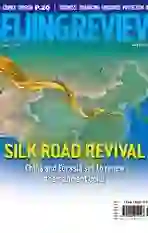Drawing a Red Line
2014-04-11ByWanghairong
By+Wang+hairong
For decades, Chinas breakneck growth has been achieved to the detriment of its environment. Now, realizing that it cannot afford to sacrifice its environment any further, the country has decided to draw a red line for the protection of ecological resources, the last line of defense for its natural environment.
The concept of the ecological red line first appeared in 2011 in a State Council circular on environmental conservation. The document said that there should be a red line on the conservation of zones with important ecological functions as well as land and sea areas with sensitive and fragile ecological environments.
Since the concept was put forward, it has received more and more attention from Chinas top leadership.
At a study session of high-ranking of- ficials on May 24, 2013, President Xi Jinping stressed that the government should set and strictly observe an ecological red line, which requires all regions to optimize, prioritize, restrict or prohibit their industrial development according to their defined nature.
More space should be provided for nature to restore itself, Xi said. He added that the functional zoning strategy should be carried out to advance urbanization, agricultural development and ecological security in a scientific and balanced way.
Drawing an ecological red line was later deemed as an important step in promoting ecological progress at the Third Plenary Session of the 18th Communist Party of China Central Committee that convened in November 2013. The meeting involved the working out of an overall plan on deepening Chinas reform in the next few years.
The proposal to draw an ecological red line is a major breakthrough in environmental protection, said Pan Jiahua, Director of the Institute for Urban and Environmental Studies at the Chinese Academy of Social Sciences (CASS).
Pan noted that as environmental and ecological deterioration is starting to affect both peoples livelihood and Chinas future development, marking an ecological red line is imperative. In the meanwhile, he said that “this task calls for quantitative research in combination with analysis on its social impacts.”
progress
“The ecological red line is the bottom line in ensuring national and regional ecological security,” said Gao Jixi, Director of the Nanjing Institute of Environmental Sciences under the Ministry of Environmental Protection (MEP).endprint
Last September, the MEP announced that the establishment of the ecological red line will be completed nationwide by the end of 2014.
Minister of Environmental Protection Zhou Shengxian said recently that the ecological red line should include specific requirements concerning ecological functions, environmental quality and resource utilization of designated zones.
Before the national ecological red line is formulated by the MEP, a number of other government departments, which are also tasked with overseeing the protection and utilization of different parts of the ecosystem, have already worked out ecological conservation targets within their respective areas.
At a meeting of forestry officials held on July 24, 2013, it was revealed that the State Forestry Administration (SFA) had drawn red lines for the protection of forestry, wetland, desert vegetation and wildlife species.
According to the administration, Chinas forest acreage should not fall below 249 million hectares and its forest stock volume should be no less than 20 billion cubic meters. It was also specified that the area of wetlands in the country should exceed 53 million hectares and at least 530,000 square km of desert should be reforested.
The SFA said that development should be banned in existing nature reserves and endangered animal and plant species should be protected.
Zhao Shucong, Administrator of the SFA, said that currently most of the targets are set above the actual quantity of available resources because actual levels are already unable to sustain a sound ecosystem.
As early as in October 2012, the State Oceanic Administration also started to designate areas for ecological conservation in the Bohai Sea, Chinas only inland sea, which has been heavily polluted.
The MEP began to study the drawing of an ecological red line in March 2012, when it set up a group to compile technical guidelines for it.
In February 2013, the MEP released a tentative guideline on establishing basic lines for zones with important ecological functions. A pilot program was launched in Jiangxi and Hubei provinces as well as Guangxi Zhuang and Inner Mongolia autonomous regions from May to August last year.
Many provincial-level governments have listed the drawing of an ecological red line as a priority on their agenda for 2014, according to their work reports to the annual sessions of local legislatures.
Chen Mengmeng, head of the Environmental Protection Department of Jiangsu Province, revealed that the province has designated 22 percent of its lands as “ecological functional areas.”endprint
